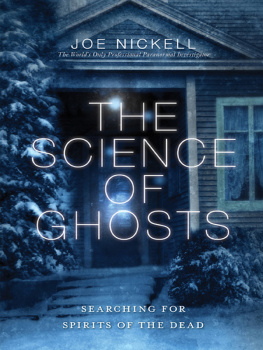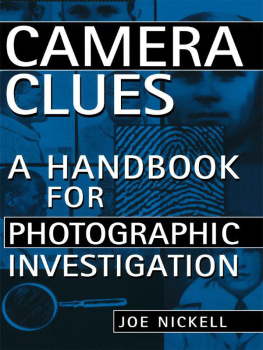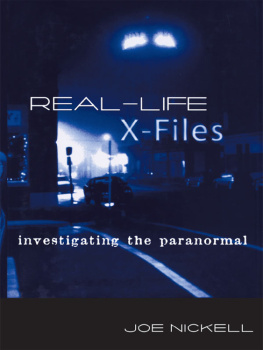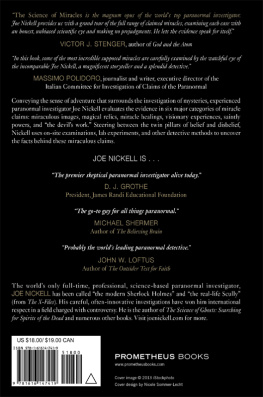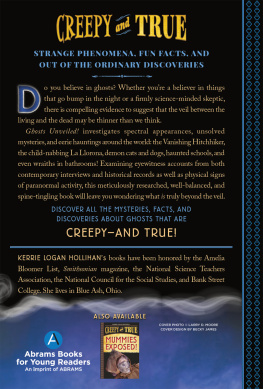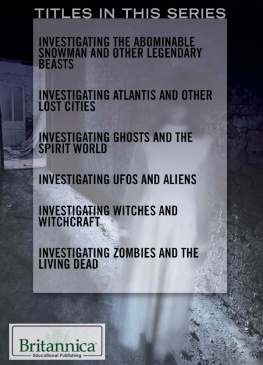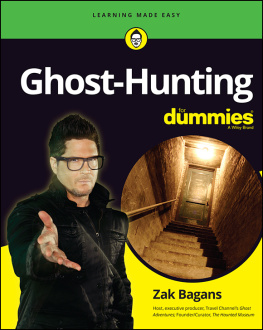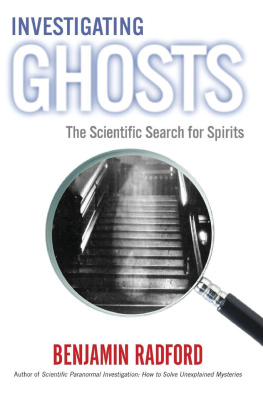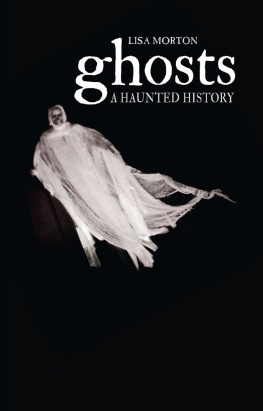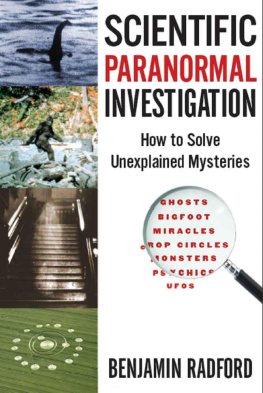
N umerous people deserve credit for helping to make this book possible.
Paul Kurtz, chairman and founder of Prometheus Books, believed in this project, and the skilled staff at Prometheus Books were again a pleasure to work with, including Steven L. Mitchell, Cate Roberts-Abel, Jade Zora Ballard, Brian McMahon, and Nicole Sommer-Lecht.
At the Center for Inquiry I am grateful to Timothy Binga, director of the Center for Inquiry Libraries for research assistance, aided by librarian Lisa Nolan; Paul E. Loynes for typesetting; Thomas Flynn for photographic expertise and other advice; my assistant, Ed Beck, for scanning and organizing illustrations; and indeed the entire CFI staff for help at all levelsespecially Ronald A. Lindsay, president and CEO; Barry Karr, executive director of CFI's Committee for Skeptical Inquiry; Kendrick Frazier, editor of Skeptical Inquirer (CFI's science magazine); and Patricia Beauchamp, Chris Fix, Julia Lavarnway, and many others. Special thanks to Ed Behr of the James Randi Educational Foundation.
I am also grateful to my wife, Diana Harris, for her assistance, and for the support of my daughter, Cherie Roycroft, and grandchildren, Chase, Tyner, and Alexis Jo, as well as my cousin John May.
In addition to those mentioned in the text, I am also indebted to the many scholars, scientists, popular writers, and other generous folk who assisted me at numerous sites around the world over the many years of this investigative effort. To all I am most appreciative.

A s my more than four decades of investigations illustrate, not a single ghost has ever been validated by science.
Despite the understandable impulse to believe in survival of consciousness, the fact remains that once the brain is dead, brain function ceases, and the phenomena on which worldwide belief in spirits rests has other, simpler explanations. This is notwithstanding the enthusiastic but misguided approach of would-be ghost hunters and sensitives.
As the late psychologist Robert A. Baker observed (1995, 275), ghosts only exist within the human head, where they are produced by the ever-active, image-creating human mind. As with other alleged paranormalities, belief in ghosts is sparked by our deepest hopes and fears, and so is worthy of our serious attention. That is why I decry alike the mystery-mongering approach of those who hype belief in ghosts and the dismissive, debunking attitude of others. As R. C. Finucane (1984, 1) sagely observed in his Appearances of the Dead, Even though ghosts or apparitions may exist only in the minds of their percipients, the fact of that existence is a social and historical reality: the phenomena represent man's inner universe just as his art and poetry do.
Thus we can be sympathetic to the impulse to believe in spirits of the dead while nevertheless recognizing such belief as a superstition that we can overcome. I hope others will share with me the desire to investigate claims of ghosts and hauntingsfor what they can tell us about ourselvesand embrace the continuing evidence that we live in a real, natural world. No ghosts, as Sherlock Holmes insisted (in The Adventure of the Sussex Vampire), need apply.

Altered state of consciousness. As defined in B. Wortman and Elizabeth F. Loftus's Psychology (1981, 613), an altered state of consciousness is any qualitative alteration in mental functioning, such that a person feels that his or her consciousness is distinctly different from the way it functions. A dissociative state is an example.
Apparitional experience. Many ghosts are perceived as apparitions, that is, ghost sightings. Often they are merely a waking dream that occurs in the interface between wakefulness and sleep. Other dissociative states, like daydreaming, can also produce ghost sightings, whereby the spectral image wells up from the subconscious and is superimposed onto the visual scene. The evidence that many ghostly perceptions are so derived is well established. For instance, Haraldsson (1988) specifically found that sightings of apparitions were linked to periods of reverie. And Andrew Mackenzie (1982) showed that in one-third of hallucinatory cases he examined, the incidents occurred to percipients just prior to or following sleep, or while they were in a relaxed state or performing routine work or concentrating on some activity like reading. The relationship between apparitional states and a dreamlike state was also observed by G. N. M. Tyrrell (1973). He noted that apparitions of people appear fully clothed and are often accompanied by objects, just as they are in dreams, because the clothes and objects are required by the apparitional drama.
Channeling. The supposed communication with such higher beings as angels, spirits, extraterrestrials, or the likeallegedly in an altered state of consciousness, such as a dissociative stateis called channeling. When it is not done as a deliberate deception, it is usually found to be an expression of fantasy proneness.
Clairvoyance. The supposed seeing of objects, people, or events through extrasensory perception (ESP). (With telepathy it constitutes one of the two main categories of ESP.) The term is French for clear seeing. Psychics reportedly using clairvoyance (or clairaudience [clear hearing] when voices or other sounds are perceived, or clairsentience [clear sensing] when involving smell, taste, or other sensations) often claim to experience ghostly phenomena (Guiley 1991, 10913). However, clairvoyants typically exhibit fantasy proneness, and all forms of ESP remain scientifically unproved. (For a specific case, see Nickell 1995, 6163.)
Confabulation. A distortion of memory, in which gaps in one's recollection are unintentionally filled in with fictional experiences (Goldenson 1970, 1:249). Thus, someone's relating of a paranormal experience, especially one of long ago, may be partially confabulated. (See also memory distortions.)
Contagion. Such simple phenomena as waking dreams, sleep paralysis, and out-of-body experiences can be transformed into ghostly encounters. The mechanism is what psychologists call contagionthe spreading of an idea, behavior, or belief from person to person by means of suggestion (Baker and Nickell 1992, 101). Historical examples of widespread contagion (often incorrectly termed mass hysteria) are the Salem witch craze of 16921693, the spiritualist excitement of the nineteenth century, and the modern ghosthunting fad. Today contagion is hugely aided by the mass media.
Dj vu. Among the most common of anomalistic experiences is the phenomenon known as dj vu (French for already seen). It is a strange feeling of familiarity, such as arriving at a never-before-visited site but experiencing the sensation of having been here before. Often, it is accompanied by the feeling that one knows what is to happen next. The brief experience then passes. Although often claimed as proof of reincarnation (see past-life recall), psychic phenomena, or spiritualistic information transfer, psychologists usually attribute the phenomenon to partial recall and faulty recognitionthat is, one has seen similar places, perhaps in photos or on television (Baker and Nickell 1992, 103107; Alcock 1996).
Dissociative state. Dissociation is the unconscious process in which a group of mental activities is separated from the main stream of consciousness, and so functions as a separate unit. (A simple example of dissociation is illustrated by the common experience of driving an automobile for miles while lost in thought, yet scarcely remembering the drive.) Such a divided mind is the explanation for the medium's automatic writing and drawing and the like (Goldenson 1970, 1:137, 33940; Baker 1990a, 18291; Wortman and Loftus 1981, 38586).
Next page
